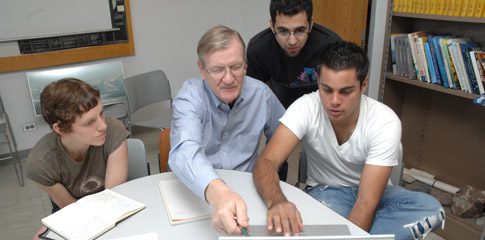Faculty Info
Name: George R. Hendrey
Title:Distinguished Professor of Environmental Science
Department: School of Earth and Environmental Sciences
Degree(s): University of Washington, BS ’68, MS ’70, PhD ’73
Contact Information:
Phone: 718-997-3325
Office: Science Bldg. Room E208
Email: George.Hendrey@qc.cuny.edu
“Our society doesn’t deal well with long, slow problems [like climate change]. It deals better with short ones, like Pearl Harbor, or 9/11.”
– George R. Hendrey
Past Profiles

George Hendrey with students: Elizabeth Bisbee, Matthew Castro and Christopher Macropolous
George Hendrey had planned to become a lawyer like the grandfather for whom he was named, a distinguished attorney who argued before the Supreme Court. But in his second year of college he took a microbiology class that changed everything. “I just got intellectually ignited by science,” he recalls. “I discovered that in science you could get clear answers to problems.”
Hendrey did his graduate work in civil engineering specialties (a master’s in water and air resources and a PhD in limnology, or freshwater ecology), giving him a firm foundation for his later scholarly work. For the first half of his career he studied the effects of acid rain on lakes and streams, including three years spent in Norway, where he designed ways to alter the acidity of streams in an isolated valley in the south of the country by precisely controlled amounts, in order to study the effects on aquatic organisms.
In 1980 Hendrey testified about the problem of acidity before a congressional committee. Part of his testimony was incorporated into the Acid Rain Act of that year, a key law that has significantly reduced air pollution.
Hendrey then turned his attention to the effects on plant systems of rising levels of carbon dioxide in the atmosphere. Again his engineering education was crucial: he designed a way to elevate the concentration of CO2 in a circular plot of farmland or forest. His method, subsequently adopted by scientists in dozens of experiments around the globe, rings the plot with vertical pipes that dispense the gas, controlling for wind with a sophisticated system of sensors and valves.
Plants slow global warming by taking up some of the CO2 that humans put into the atmosphere by burning fossil fuels. By elucidating the process, Hendrey’s experimental approach is helping scientists understand how increasing atmospheric CO2 may change the biosphere, and how such changes may feed back on the rate of global warming.
His work has not left Hendrey optimistic. “CO2 emissions, and expected warming, are well above” what had been predicted even a year or two ago, he says. He notes that because of human releases of CO2, climate scientists anticipate more strong storms from the Atlantic, with increasing likelihood for a storm surge calamity from a hurricane in New York City.
Hendrey started teaching at Queens in 2004, after 27 years at the Brookhaven National Laboratory on Long Island. “Most of my students are eager to learn and many of them are especially interested in climate change,” he says. “What I like most about Queens,” he adds, “is the diversity of our students. They come from every sort of background and perhaps represent a cross section of America’s population as it might be a few decades from now.”
Favorite book: How Societies Choose to Fail or Succeed, by Jared Diamond.
Favorite musicians: Beethoven, Mozart, Jimi Hendrix

